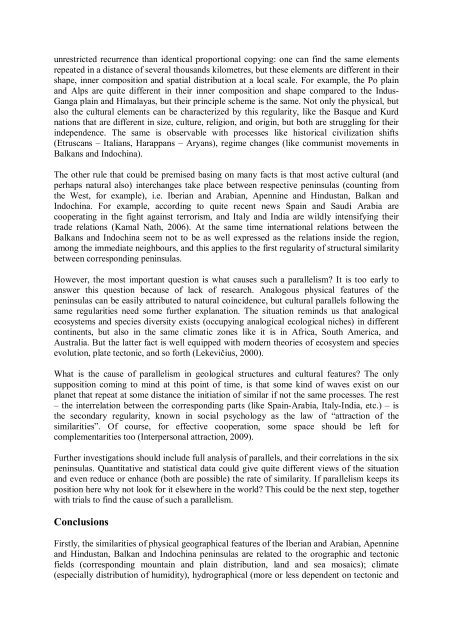Parallels in nature and culture diversity of the European and Asian ...
Parallels in nature and culture diversity of the European and Asian ...
Parallels in nature and culture diversity of the European and Asian ...
You also want an ePaper? Increase the reach of your titles
YUMPU automatically turns print PDFs into web optimized ePapers that Google loves.
unrestricted recurrence than identical proportional copy<strong>in</strong>g: one can f<strong>in</strong>d <strong>the</strong> same elementsrepeated <strong>in</strong> a distance <strong>of</strong> several thous<strong>and</strong>s kilometres, but <strong>the</strong>se elements are different <strong>in</strong> <strong>the</strong>irshape, <strong>in</strong>ner composition <strong>and</strong> spatial distribution at a local scale. For example, <strong>the</strong> Po pla<strong>in</strong><strong>and</strong> Alps are quite different <strong>in</strong> <strong>the</strong>ir <strong>in</strong>ner composition <strong>and</strong> shape compared to <strong>the</strong> Indus-Ganga pla<strong>in</strong> <strong>and</strong> Himalayas, but <strong>the</strong>ir pr<strong>in</strong>ciple scheme is <strong>the</strong> same. Not only <strong>the</strong> physical, butalso <strong>the</strong> cultural elements can be characterized by this regularity, like <strong>the</strong> Basque <strong>and</strong> Kurdnations that are different <strong>in</strong> size, <strong>culture</strong>, religion, <strong>and</strong> orig<strong>in</strong>, but both are struggl<strong>in</strong>g for <strong>the</strong>ir<strong>in</strong>dependence. The same is observable with processes like historical civilization shifts(Etruscans – Italians, Harappans – Aryans), regime changes (like communist movements <strong>in</strong>Balkans <strong>and</strong> Indoch<strong>in</strong>a).The o<strong>the</strong>r rule that could be premised bas<strong>in</strong>g on many facts is that most active cultural (<strong>and</strong>perhaps natural also) <strong>in</strong>terchanges take place between respective pen<strong>in</strong>sulas (count<strong>in</strong>g from<strong>the</strong> West, for example), i.e. Iberian <strong>and</strong> Arabian, Apenn<strong>in</strong>e <strong>and</strong> H<strong>in</strong>dustan, Balkan <strong>and</strong>Indoch<strong>in</strong>a. For example, accord<strong>in</strong>g to quite recent news Spa<strong>in</strong> <strong>and</strong> Saudi Arabia arecooperat<strong>in</strong>g <strong>in</strong> <strong>the</strong> fight aga<strong>in</strong>st terrorism, <strong>and</strong> Italy <strong>and</strong> India are wildly <strong>in</strong>tensify<strong>in</strong>g <strong>the</strong>irtrade relations (Kamal Nath, 2006). At <strong>the</strong> same time <strong>in</strong>ternational relations between <strong>the</strong>Balkans <strong>and</strong> Indoch<strong>in</strong>a seem not to be as well expressed as <strong>the</strong> relations <strong>in</strong>side <strong>the</strong> region,among <strong>the</strong> immediate neighbours, <strong>and</strong> this applies to <strong>the</strong> first regularity <strong>of</strong> structural similaritybetween correspond<strong>in</strong>g pen<strong>in</strong>sulas.However, <strong>the</strong> most important question is what causes such a parallelism? It is too early toanswer this question because <strong>of</strong> lack <strong>of</strong> research. Analogous physical features <strong>of</strong> <strong>the</strong>pen<strong>in</strong>sulas can be easily attributed to natural co<strong>in</strong>cidence, but cultural parallels follow<strong>in</strong>g <strong>the</strong>same regularities need some fur<strong>the</strong>r explanation. The situation rem<strong>in</strong>ds us that analogicalecosystems <strong>and</strong> species <strong>diversity</strong> exists (occupy<strong>in</strong>g analogical ecological niches) <strong>in</strong> differentcont<strong>in</strong>ents, but also <strong>in</strong> <strong>the</strong> same climatic zones like it is <strong>in</strong> Africa, South America, <strong>and</strong>Australia. But <strong>the</strong> latter fact is well equipped with modern <strong>the</strong>ories <strong>of</strong> ecosystem <strong>and</strong> speciesevolution, plate tectonic, <strong>and</strong> so forth (Lekevičius, 2000).What is <strong>the</strong> cause <strong>of</strong> parallelism <strong>in</strong> geological structures <strong>and</strong> cultural features? The onlysupposition com<strong>in</strong>g to m<strong>in</strong>d at this po<strong>in</strong>t <strong>of</strong> time, is that some k<strong>in</strong>d <strong>of</strong> waves exist on ourplanet that repeat at some distance <strong>the</strong> <strong>in</strong>itiation <strong>of</strong> similar if not <strong>the</strong> same processes. The rest– <strong>the</strong> <strong>in</strong>terrelation between <strong>the</strong> correspond<strong>in</strong>g parts (like Spa<strong>in</strong>-Arabia, Italy-India, etc.) – is<strong>the</strong> secondary regularity, known <strong>in</strong> social psychology as <strong>the</strong> law <strong>of</strong> “attraction <strong>of</strong> <strong>the</strong>similarities”. Of course, for effective cooperation, some space should be left forcomplementarities too (Interpersonal attraction, 2009).Fur<strong>the</strong>r <strong>in</strong>vestigations should <strong>in</strong>clude full analysis <strong>of</strong> parallels, <strong>and</strong> <strong>the</strong>ir correlations <strong>in</strong> <strong>the</strong> sixpen<strong>in</strong>sulas. Quantitative <strong>and</strong> statistical data could give quite different views <strong>of</strong> <strong>the</strong> situation<strong>and</strong> even reduce or enhance (both are possible) <strong>the</strong> rate <strong>of</strong> similarity. If parallelism keeps itsposition here why not look for it elsewhere <strong>in</strong> <strong>the</strong> world? This could be <strong>the</strong> next step, toge<strong>the</strong>rwith trials to f<strong>in</strong>d <strong>the</strong> cause <strong>of</strong> such a parallelism.ConclusionsFirstly, <strong>the</strong> similarities <strong>of</strong> physical geographical features <strong>of</strong> <strong>the</strong> Iberian <strong>and</strong> Arabian, Apenn<strong>in</strong>e<strong>and</strong> H<strong>in</strong>dustan, Balkan <strong>and</strong> Indoch<strong>in</strong>a pen<strong>in</strong>sulas are related to <strong>the</strong> orographic <strong>and</strong> tectonicfields (correspond<strong>in</strong>g mounta<strong>in</strong> <strong>and</strong> pla<strong>in</strong> distribution, l<strong>and</strong> <strong>and</strong> sea mosaics); climate(especially distribution <strong>of</strong> humidity), hydrographical (more or less dependent on tectonic <strong>and</strong>
















